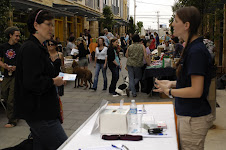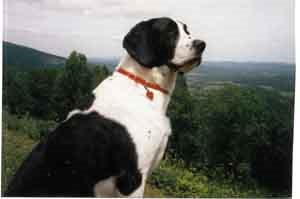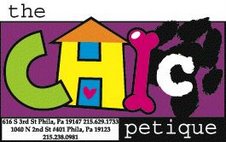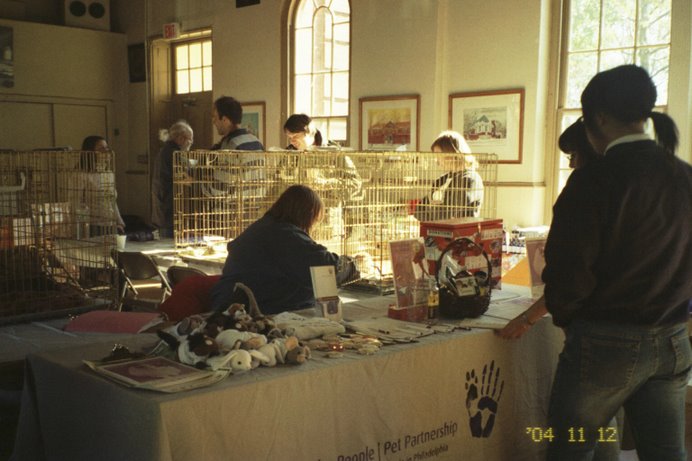
This years NATURAL PET EXPO will take place in Philadelphia, PA from 10am to 4pm at 1040 N 2nd Street in the courtyard of the Liberties Walk complex in Northern Liberties.
The theme this year is PET FOOD & NUTRITION.
Starting at NOON - hear LIVE MUSIC from acoustic and folk/blues artists Pete Tramo and Williamzboy. Check out their musical offerings at www.myspace.com/octobertreeproject and www.myspace.com/folkabilly
At 1pm, Veterinarian Jennifer Forsyth, V.M.D from Bethel Mill Animal Hospital will give a talk on the Pet Food Recall -- Making the Right Choices for Your Pet. Find out exactly what to look for and what to avoid on pet food labels and how to pick the best food for your pet. Is raw food the best alternative? Dr. Forsyth will talk about the benefits, weigh the costs versus the time and give you THE answers you need to make informed and -safe- decisions for your pet. You won't want to miss this. NEXT, Dr. Karen Hoffman, from Mt. Laurel Animal Hospital will give a talk on "Safe Alternatives to NSAIDS/Aspirin" and "The Importance of Animal Dentistry"
 See what else you'll find at the Natural Pet Expo!
See what else you'll find at the Natural Pet Expo! + PET FOOD AND NUTRITION Find out what food is BEST (and worst) for your pet!
+ ARE VACCINATIONS DANGEROUS? Evaluate true risk of exposure – get informed.
+ HOMEOPATHIC & HOLISTIC CARE What is it and what are the benefits for your pet?
+ ALTERNATIVE CARE Learn about Reiki, Pet Massage, Acupuncture, Chiropractics, Flower Essences, Young Living Oils, Amazon Herbs and other all-natural care and health options.
+ ALL- NATURAL FLEA REMEDIES, BEST SELLING BOOKS, TREATS, TOYS AND MUCH MORE!
BE PROACTIVE AND RESPONSIBLE -- Talk to the experts and get the REAL scoop on the safety of commercial pet foods, learn about alternative health care and how to recognize the benefits & limitations of conventional and holistic options for your animal companion.
Our Sponsors this year are Chic Petique pet stores, dedicated to the natural care and wellness of your pet and serving you in two convenient locations, 3rd & South Streets and 1040 N. 2nd Street in the Liberties Walk retail Courtyard in Northern Liberties. Coming back for a 2nd year is
 NATURE'S VARIETY The Nature's Variety line of natural pet products was developed by families who have been engaged in sustainable production agriculture for over 140 years - raising quality livestock and growing crops in America's heartland. They are passionate about improving the health of your pet through better nutrition. With better ingredients and better nutrition, you can help your pet maintain proper body weight, reduce the risk of allergies, and enjoy a longer, healthier life by maintaining a healthy diet. They select the highest quality ingredients for the production of nutritionally dense and bio-available diets anhttp://www.blogger.com/img/gl.link.gifd treats. Their natural, nutritious products are produced with integrity and care for the health of your companion animal.
NATURE'S VARIETY The Nature's Variety line of natural pet products was developed by families who have been engaged in sustainable production agriculture for over 140 years - raising quality livestock and growing crops in America's heartland. They are passionate about improving the health of your pet through better nutrition. With better ingredients and better nutrition, you can help your pet maintain proper body weight, reduce the risk of allergies, and enjoy a longer, healthier life by maintaining a healthy diet. They select the highest quality ingredients for the production of nutritionally dense and bio-available diets anhttp://www.blogger.com/img/gl.link.gifd treats. Their natural, nutritious products are produced with integrity and care for the health of your companion animal. And joining us in 2007 as a new sponsor is WHOLE FOODS!

Whole Foods believe in a virtuous circle entwining the food chain, human beings and Mother Earth: each is reliant upon the others through a beautiful and delicate symbiosis.
Whole Foods obtains products locally and from all over the world, often from small, uniquely dedicated food artisans. They strive to offer the highest quality, least processed, most flavorful and naturally preserved foods. Why? Because food in its purest state — unadulterated by artificial additives, sweeteners, colorings and preservatives — is the best tasting and most nutritious food available. Whole Foods also believe companies, like individuals, must assume their share of responsibility as tenants of Planet Earth.
The Natural Pet Expo team offers infinite gratitude & thanks our sponsors for all their generous support of our cause!




































